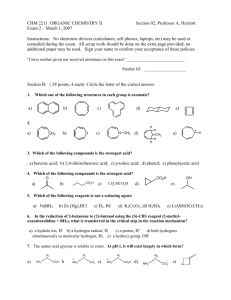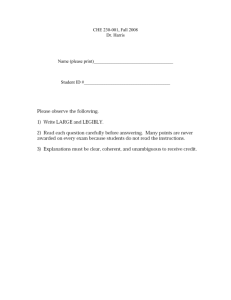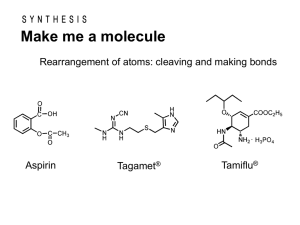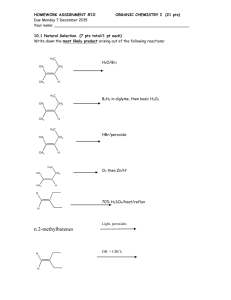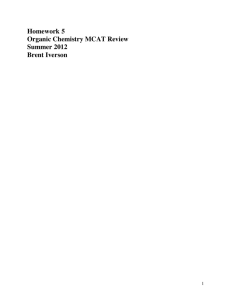Stereochemistry Lab Exercise(WU) Rev 6
advertisement
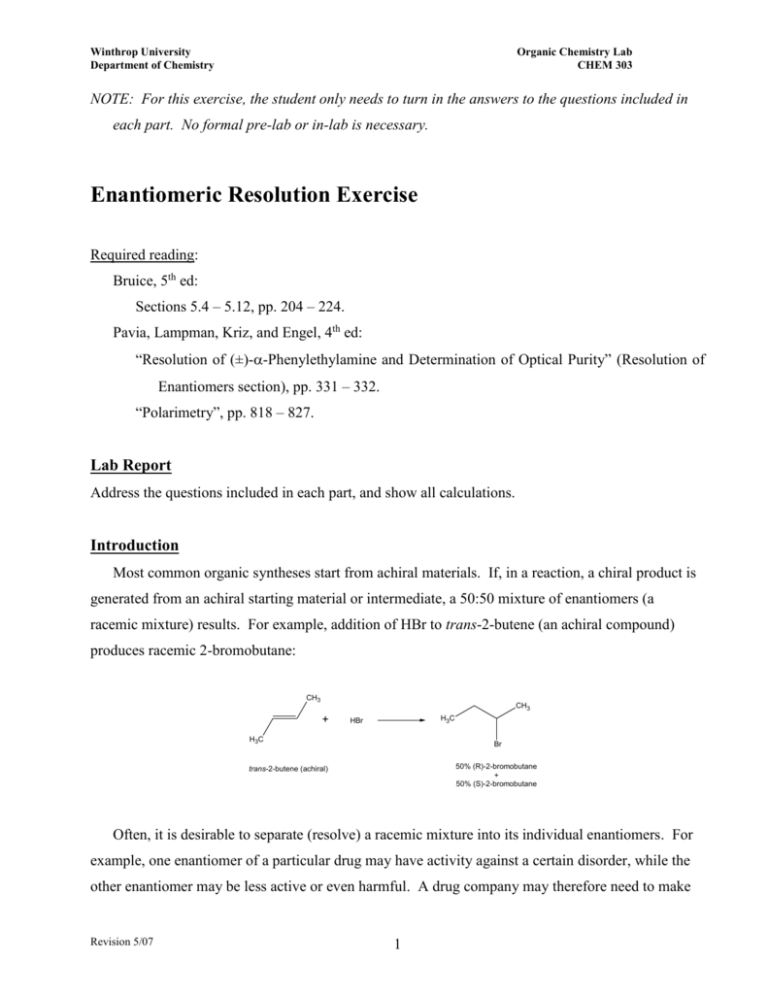
Winthrop University Department of Chemistry Organic Chemistry Lab CHEM 303 NOTE: For this exercise, the student only needs to turn in the answers to the questions included in each part. No formal pre-lab or in-lab is necessary. Enantiomeric Resolution Exercise Required reading: Bruice, 5th ed: Sections 5.4 – 5.12, pp. 204 – 224. Pavia, Lampman, Kriz, and Engel, 4th ed: “Resolution of (±)--Phenylethylamine and Determination of Optical Purity” (Resolution of Enantiomers section), pp. 331 – 332. “Polarimetry”, pp. 818 – 827. Lab Report Address the questions included in each part, and show all calculations. Introduction Most common organic syntheses start from achiral materials. If, in a reaction, a chiral product is generated from an achiral starting material or intermediate, a 50:50 mixture of enantiomers (a racemic mixture) results. For example, addition of HBr to trans-2-butene (an achiral compound) produces racemic 2-bromobutane: CH3 CH3 + H3C HBr H3C Br 50% (R)-2-bromobutane + 50% (S)-2-bromobutane trans-2-butene (achiral) Often, it is desirable to separate (resolve) a racemic mixture into its individual enantiomers. For example, one enantiomer of a particular drug may have activity against a certain disorder, while the other enantiomer may be less active or even harmful. A drug company may therefore need to make Revision 5/07 1 Winthrop University Department of Chemistry Organic Chemistry Lab CHEM 303 the drug as a racemic mixture, then separate the individual enantiomers so only the active enantiomer will be packaged and sold. This separation of a racemic mixture into its individual enantiomers is known as resolution. The resolution of a racemic mixture cannot be accomplished using standard physical means (e. g. distillation, recrystallization, or chromatography), because enantiomers have identical physical properties, except for the direction of rotation of plane polarized light. To distinguish between the components of a racemic mixture, a chiral probe (something capable of distinguishing between enantiomers) must be used. When a chiral probe is used to resolve a racemic mixture into its enantiomers, it is called a resolving agent. Traditionally, the method for resolving a racemic mixture is to react the racemate with an enantiomerically pure compound (often a readily available natural product). When the enantiomers that make up the racemate form bonds with the enantiomerically pure resolving agent, a mixture of diastereomers is formed. Unlike enantiomers, diastereomers have different physical properties (boiling point, solubility, etc.) and can be separated by typical physical methods. Once the diastereomers are separated, they are subjected to conditions under which the reverse reaction occurs, and the original enantiomers are recovered. The process can be described schematically as follows: (R,S) (Racemic) + (S’) (Resolving Agent) (R,S’) + (S,S’) Mixture of Diastereomers Separation Recovery (pure R) Enantiomers are “Resolved” (R,S’) (S,S’) (- S’) (pure S) To illustrate the steps involved in an enantiomeric resolution, consider the resolution of a racemic mixture of 2-aminobutane using (R,R)-(+)-tartaric acid (available in large quantities as a by product of winemaking). 2-Aminobutane reacts with (R,R)-tartaric acid in hot water solution to form a mixture of diasteromeric amine salts: Revision 5/07 2 Winthrop University Department of Chemistry Organic Chemistry Lab CHEM 303 NH2 H3C CO2H H CH3 + H OH HO + NH3 H3C H H + H3N OH CH3 HO H + CO2 H H CH3 HO H3C CO2H CO2H Racemic 2-aminobutane CO2 (R,R)-(+)-tartaric acid OH H CO2H (R)-amine-(R,R)-tartrate (S)-amine-(R,R)-tartrate The diastereomeric salts have differing solubilities in water, so upon cooling the solution to room temperature, the less soluble (S,R,R) salt crystallizes out and is isolated by filtration, leaving the more soluble (R,R,R) salt in solution. The (R,R,R) salt is then isolated by evaporation of the solvent: H H3C + NH3 CO2 H + H3N OH CH3 HO H + CO2 H H CH3 HO H3C CO2H OH H CO2H (R)-amine-(R,R)-tartrate (S)-amine-(R,R)-tartrate Crystallization/ Filtration Evaporation of mother liquor (isolation of less soluble diastereomer) + H3N H3C H CH3 CO2 H OH HO H CO2H CO2 H CH3 H H3C + NH3 (R)-amine-(R,R)-tartrate OH HO H CO2H (S)-amine-(R,R)-tartrate The individual enantiomers are then recovered by treatment of the individual salts with aqueous base: Revision 5/07 3 Winthrop University Department of Chemistry Organic Chemistry Lab CHEM 303 + H3N CO2 H H3C CH3 H OH HO H2N KOH/H2O H H3C CO2H (S)-amine-(R,R)-tartrate H CH3 CH3 (S)-2-aminobutane + CO2 NH3 H3C H H OH HO H KOH/H2O H H3C CO2H NH2 CH3 (R)-2-aminobutane (R)-amine-(R,R)-tartrate The optical purity of each product can then be determined by polarimetry as described in Pavia, Lampman, Kriz, and Engel, 4th ed. pp. 819 – 827 to evaluate the efficiency of the resolution. Part 1 For the following problem, the following information will be helpful: NH2 O NH2 HO H CH3 CH3 H OH HO O (R)-(+)--Phenylethylamine o []22 D = +40.3 mw = 121.18 + H CH3 (S)-(-)-Malic acid []D = -2.3o mw = 134.09 (S)-(-)--Phenylethylamine o []22 D = -40.3 mw = 121.18 + O NH3 H O NH3 HO HO O O HO CH3 H - H - O O (S, S)--Phenylethylammonium malate Solubility in water (25 °C) > 0.3 g/mL HO H (R, S)--Phenylethylammonium malate Solubility in water (25 °C) < 0.1 g/mL (S)-(-)-Malic acid (also known as apple sugar) is used as a coating in many “extreme sour” candies like MegaWarheads to give the initial “extreme sour” taste to the product. It is an abundant chirally pure material, and therefore can be used as an inexpensive resolving agent for the Revision 5/07 4 Winthrop University Department of Chemistry Organic Chemistry Lab CHEM 303 separation of enantiomeric amines. As the new chemist working at “Drugs Я Us”, you are given the task of resolving racemic -phenylethylamine into its individual enantiomers. 1. Draw a flowchart (include structures) illustrating how you will resolve racemic -phenylethylamine into (R)-(+)--phenylethylamine and (S)-(-)--phenylethylamine using (S)-(-)-malic acid as the resolving agent. 2. After you carried out your resolution, you labeled the products you isolated “Sample A” and “Sample B”. You subjected both samples to polarimetry ( = 589 nm (sodium D-line), 1-dm cell) and obtained the following results: Sample A: 1.00 g dissolved in methanol and diluted to 10.0 mL gave an observed rotation () at 22 °C of + 4.00°. Sample B: 1.00 g dissolved in methanol and diluted to 10.0 mL gave an observed rotation () at 22 °C of – 2.42°. For samples A and B, identify the predominant enantiomer and calculate the specific rotation for each sample. Also, calculate the optical purity (enantiomeric excess) of each sample as well as the % of each enantiomer present in each sample. Show your calculations. Part 2 You were so successful at resolving racemic -phenylethylamine, your boss has given you another task. She wants to know if you can suggest ways to resolve the following racemic compounds: CH3 OH (a) N N (b) O CH3 H3C nicotine CH3 ibuprofen Describe how you might resolve each of these racemic compounds. (Advice from the boss: a flowchart (including structures) is a very good way to show the steps involved in this operation.) Revision 5/07 5
